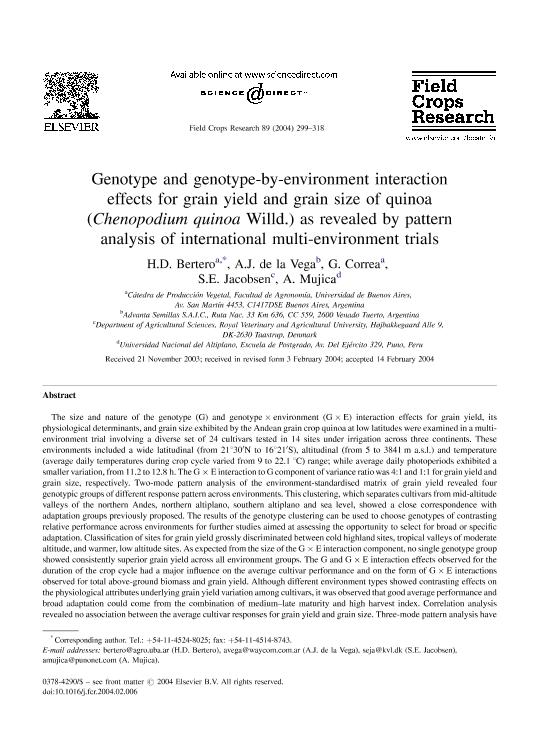Artículo
Genotype and genotype-by-environment interaction effects for grain yield and grain size of quinoa (Chenopodium quinoa Willd.) as revealed by pattern analysis of international multi-environment trials
Bertero, Hector Daniel ; De La Vega, A. J.; Correa Tedesco, Guillermo Oscar
; De La Vega, A. J.; Correa Tedesco, Guillermo Oscar ; Jacobsen, S. E.; Mujica, A.
; Jacobsen, S. E.; Mujica, A.
 ; De La Vega, A. J.; Correa Tedesco, Guillermo Oscar
; De La Vega, A. J.; Correa Tedesco, Guillermo Oscar ; Jacobsen, S. E.; Mujica, A.
; Jacobsen, S. E.; Mujica, A.
Fecha de publicación:
10/2004
Editorial:
Elsevier Science
Revista:
Field Crops Research
ISSN:
0378-4290
e-ISSN:
1872-6852
Idioma:
Inglés
Tipo de recurso:
Artículo publicado
Clasificación temática:
Resumen
The size and nature of the genotype (G) and genotype×environment (G×E) interaction effects for grain yield, its physiological determinants, and grain size exhibited by the Andean grain crop quinoa at low latitudes were examined in a multi-environment trial involving a diverse set of 24 cultivars tested in 14 sites under irrigation across three continents. These environments included a wide latitudinal (from 21°30′N to 16°21′S), altitudinal (from 5 to 3841 m a.s.l.) and temperature (average daily temperatures during crop cycle varied from 9 to 22.1°C) range; while average daily photoperiods exhibited a smaller variation, from 11.2 to 12.8 h. The G×E interaction to G component of variance ratio was 4:1 and 1:1 for grain yield and grain size, respectively. Two-mode pattern analysis of the environment-standardised matrix of grain yield revealed four genotypic groups of different response pattern across environments. This clustering, which separates cultivars from mid-altitude valleys of the northern Andes, northern altiplano, southern altiplano and sea level, showed a close correspondence with adaptation groups previously proposed. The results of the genotype clustering can be used to choose genotypes of contrasting relative performance across environments for further studies aimed at assessing the opportunity to select for broad or specific adaptation. Classification of sites for grain yield grossly discriminated between cold highland sites, tropical valleys of moderate altitude, and warmer, low altitude sites. As expected from the size of the G×E interaction component, no single genotype group showed consistently superior grain yield across all environment groups. The G and G×E interaction effects observed for the duration of the crop cycle had a major influence on the average cultivar performance and on the form of G×E interactions observed for total above-ground biomass and grain yield. Although different environment types showed contrasting effects on the physiological attributes underlying grain yield variation among cultivars, it was observed that good average performance and broad adaptation could come from the combination of medium-late maturity and high harvest index. Correlation analysis revealed no association between the average cultivar responses for grain yield and grain size. Three-mode pattern analysis have also shown no association between the G×E interaction effects for both traits. Both observations indicate that simultaneous progress for grain yield and grain size can be expected from selection.
Archivos asociados
Licencia
Identificadores
Colecciones
Articulos(OCA PQUE. CENTENARIO)
Articulos de OFICINA DE COORDINACION ADMINISTRATIVA PQUE. CENTENARIO
Articulos de OFICINA DE COORDINACION ADMINISTRATIVA PQUE. CENTENARIO
Citación
Bertero, Hector Daniel; De La Vega, A. J.; Correa Tedesco, Guillermo Oscar; Jacobsen, S. E.; Mujica, A.; Genotype and genotype-by-environment interaction effects for grain yield and grain size of quinoa (Chenopodium quinoa Willd.) as revealed by pattern analysis of international multi-environment trials; Elsevier Science; Field Crops Research; 89; 2-3; 10-2004; 299-318
Compartir
Altmétricas



